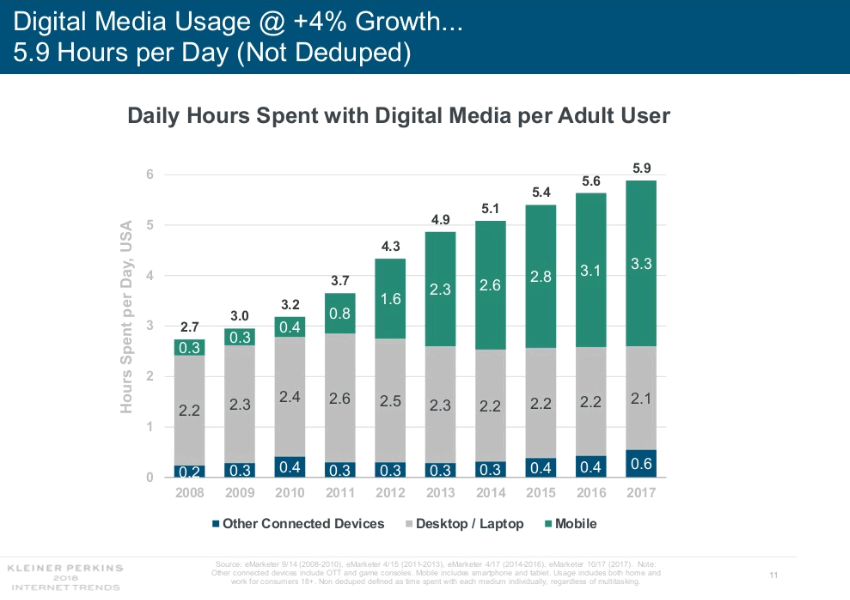Experts Predict Five Big Internet Trends To Watch

As summer ends, a good read—the annual Meeker Internet Trend ReportExit Disclaimer is a highly anticipated resource for understanding today's digital landscape and identifying emerging social media and digital trends. (You can download the full reportExit Disclaimer [PDF, 6.4MB] .) A recent TechCrunch articleExit Disclaimer summarized some of the 2018 report's findings:
- Internet adoption: As of 2018, half the world's population (~3.6 billion people) is using the Internet, thanks, according to TechCrunchExit Disclaimer, to the availability of cheaper Android phones and increased access to WiFi.
- Mobile usage: TechCrunch notesExit Disclaimer that U.S. adults are spending more time online thanks to mobile. In 2017, they clocked 5.9 hours per day online in 2017 versus 5.6 hours/day in 2016.
- Mobile ads: TechCrunch also highlightedExit Disclaimer the fact that people are shifting their time to mobile
- Voice: According to TechCrunchExit Disclaimer, voice technology has reached a key turning point, with speech recognition hitting 95% accuracy.
In addition, the report noted the following trends:
1. Global digital media usage continues to grow: TechCrunch reports that:
- Mobile video usageExit Disclaimer has been sharply increasing each year since 2012.
- Due to increased global access to the Internet and social media penetration, technology disruption, cheaper connectivity, and data sharing are increasingExit Disclaimer.
- Time spent on digital mediaExit Disclaimer increased from 3 hours/day in 2009 to almost 6 hours/day in 2017.
2. Individuals are turning to the Internet for professional development and job opportunities - the Mary Meeker report notes that:
- Employees are seeking retraining and educationExit Disclaimer from online video platforms and online courses to keep up with new job requirements.
- Thirty percent of today's online learnersExit Disclaimer are from North America, as compared to 28% from Asia and 20% from Europe.
- Job search videos (e.g., resume-writing guides) online increased 40%Exit Disclaimer between 2016 and 2017.
3. Online networks are driving offline community connections - the report shows:
- Sites like Nextdoor are strengthening online connectionsExit Disclaimer within neighborhoods
- Online searches for products and/or services "near me" increased 900%Exit Disclaimer between 2015 and 2017
4. Social media is driving behaviors, like online purchasing - as indicated by the Meeker report:
- Online users are discovering products via social media sitesExit Disclaimer: Facebook (78%), Instagram (59%), Pinterest (59%), and Twitter (34%).
- Referrals from social media to ecommerce sites increased by 4% Exit Disclaimerin the last year.
- Facebook users are engaging more with adsExit Disclaimer on the site.
5. Public trust in online information and tools may be declining: Meeker reports:
- Content delivery platforms are re-evaluating user-generated contentExit Disclaimer to ensure greater accuracy and accountability.
- In the last 12 monthsExit Disclaimer 47% adjusted mobile privacy settings; 28% disabled cookies; etc.
Michael D. Shankle, MPH, Senior Director of Capacity Building at HealthHIV, noted: "It's an exciting time in technology advancement—especially related to health care—on both the individual and practice fronts. HealthHIV is applying and integrating this innovation in our capacity-building programs. Telemedicine (clinician to patient), real-time data-sharing, social-network engagement, and geo-mapping and positioning of services are just a few of the areas which enhance access to data to make informed decisions and positively impact delivery systems and health outcome."
To talk with an HIV.gov digital expert about how digital and social media trends could affect your HIV communications work, make a Virtual Office Hours appointment today!